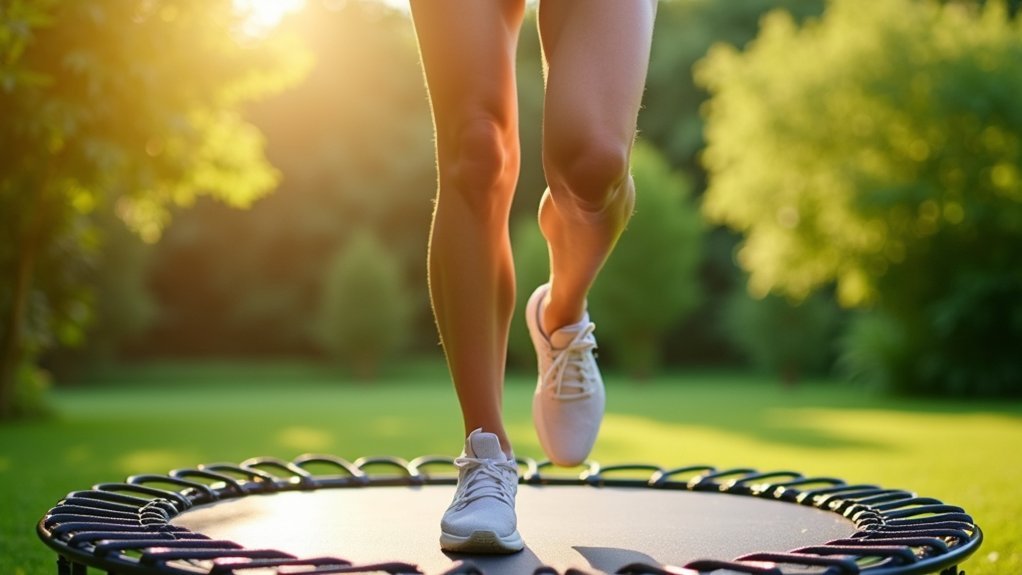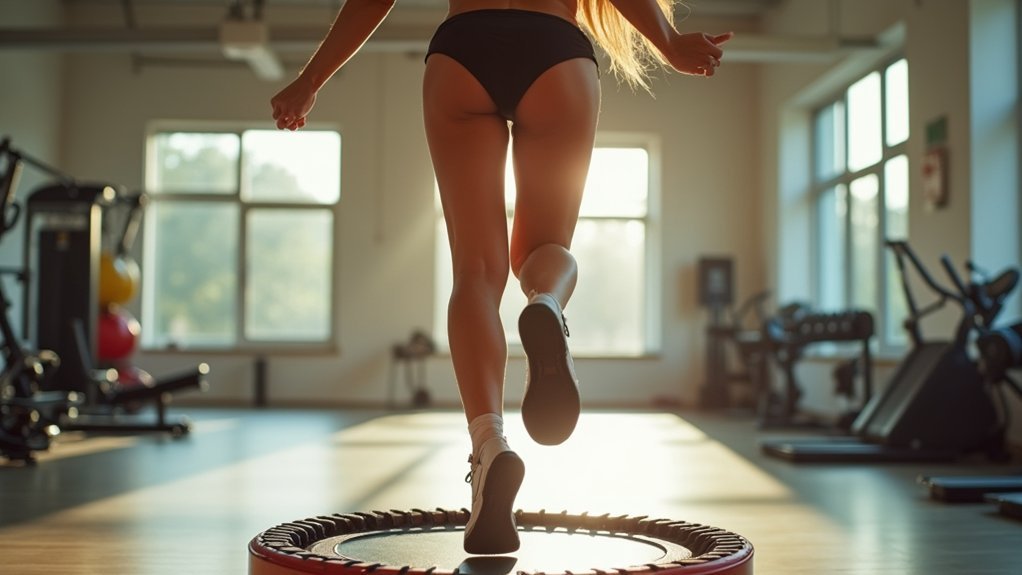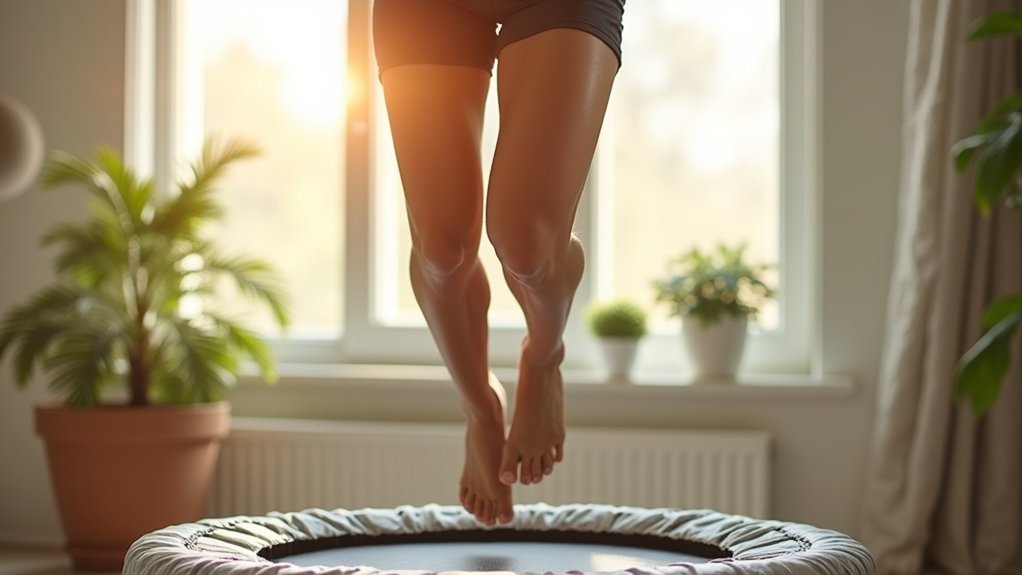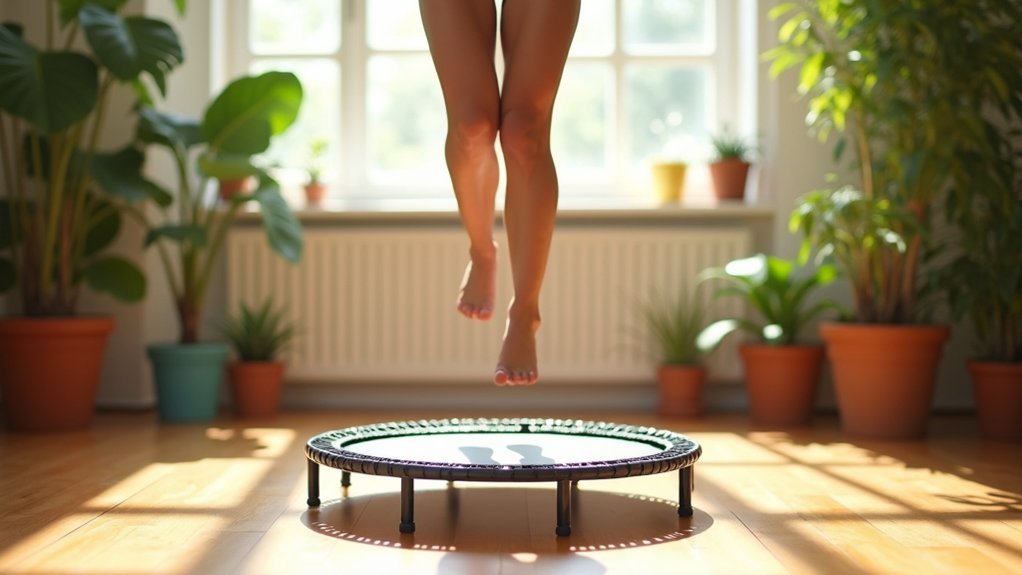Regular mini-trampoline exercise has been proven to reduce cellulite through multiple mechanisms. You’ll benefit from increased lymphatic flow, enhanced circulation to cellulite-prone areas, and muscle toning of thighs and glutes. The bouncing motion helps break down fat deposits while strengthening connective tissue that supports skin. Within 2-3 weeks of consistent rebounding (3-4 sessions weekly), you’ll notice smoother skin texture and improved body composition. Discover how this low-impact exercise outperforms many traditional cellulite-fighting workouts.
The Science Behind Cellulite Formation and Visibility

Although cellulite affects nearly 90% of women regardless of weight or fitness level, its formation stems from specific structural differences in female anatomy.
Your skin connects to underlying muscle through fibrous bands called septa, which run parallel in women but crisscross in men. This parallel orientation creates weak points where fat cells can push through.
When fat expands in your superficial layer, it creates upward pressure against these weakened junctions. The resulting tension imbalance—inward septal pull versus outward fat pressure—creates the characteristic dimpling you see.
Hormones play a significant role too; estrogen increases fat storage and fluid retention while reducing collagen production in connective tissues.
As you age, thinning dermal layers provide less resistance to these fat protrusions, making cellulite more visible.
How Rebounding Targets Cellulite-Prone Areas
Rebounding workouts specifically challenge your thighs, buttocks, and abdomen—the areas most susceptible to cellulite—through multi-directional movements and isometric contractions that build lean muscle beneath troublesome fat deposits.
Your body’s circulatory response to bouncing sends oxygen-rich blood directly to these problem zones, expanding the capillary network in lateral thighs and upper arms where circulation typically falls short.
The combination of targeted muscle toning and improved blood flow creates a one-two punch against cellulite, simultaneously strengthening underlying structures while enhancing your skin’s elasticity and appearance. The hypergravity effect created during trampoline exercises produces an effective compression of vessels that promotes lymphatic drainage and helps eliminate toxins from cellulite-prone areas.
Muscle-Toning Effects
The transformative power of mini-trampoline exercise lies in its unique ability to tone muscles in areas where cellulite commonly appears. When you rebound regularly, you’re strengthening your thighs, buttocks, and hips—precisely where cellulite tends to develop most visibly.
As you bounce, your core engages to maintain balance, while your leg muscles work to propel and stabilize your movements. This consistent muscle activation helps replace fat deposits with lean muscle fiber, creating a smoother, more even skin appearance. Rebounding particularly strengthens common areas for cellulite development including the hips, arms, thighs, and abdomen.
Your pelvic floor also benefits from this low-impact yet high-intensity exercise. Even short 10-minute sessions can be effective when done consistently.
As muscles develop underneath problem areas, they push outward against the skin, reducing that dimpled appearance and creating a more toned silhouette.
Circulation Improvement Zones
While traditional cellulite treatments often fall short, mini-trampoline exercise transforms blood circulation precisely where you need it most.
Regular rebounding targets thighs, buttocks, and legs—areas most prone to cellulite development.
When you bounce, you’re stimulating lymphatic movement in your lower body, enhancing microcirculation in troublesome zones. This increased blood flow helps remove toxins and reduce fluid retention, directly addressing cellulite’s root causes.
Your pelvic region and core also benefit, creating a thorough circulation improvement network that extends to all lower extremities.
The consistent up-and-down motion delivers oxygen-rich blood to tissues, improving skin elasticity and collagen remodeling.
For maximum benefit, maintain consistent sessions of moderate intensity, gradually increasing duration as your fitness improves.
You’ll notice measurable changes in both circulation and cellulite appearance.
Muscle Toning Effects on Skin Appearance

As you bounce on a mini-trampoline, your body experiences more than just cardiovascular benefits—it’s simultaneously engaging in deep muscle toning that dramatically improves skin appearance. When muscles beneath your skin become firmer and more defined, they help lift and tighten the overlying tissue, reducing the dimpled appearance of cellulite.
| Muscle Toning Effect | Skin Improvement |
|---|---|
| Increased muscle definition | Smoother skin surface |
| Enhanced collagen production | Improved elasticity |
| Better circulation | Reduced puffiness |
| Stronger connective tissue | Diminished cellulite visibility |
Regular rebounding stimulates collagen synthesis, counteracting the natural loss associated with aging. This process helps maintain your skin’s elasticity and youthful appearance. You’ll notice that as your muscles become more toned through consistent mini-trampoline exercise, your skin appears firmer and more rejuvenated.
Circulation Improvements From Mini-Trampoline Workouts
When your feet rhythmically bounce on a mini-trampoline, your entire circulatory system springs into action, creating a powerful cascade of blood flow benefits. This low-impact workout generates unique gravitational forces that enhance both vascular compliance and endothelial function.
Unlike traditional cardio, rebounding creates vertical acceleration/deceleration forces that supercharge your lymphatic system, actively pumping fluid through vessels that lack their own pumping mechanism. Studies show these movements reduce fluid retention while improving nutrient delivery to skin tissues.
The multiplanar movements you’ll perform—like cross-overs and rotational jumps—stimulate circulation in often-neglected peripheral areas. This enhanced microcirculation delivers more oxygen to dermal layers while promoting waste removal, potentially reducing cellulite’s appearance by minimizing fluid pooling and supporting collagen synthesis. Rebounding is particularly beneficial for those over 50 as it provides easier on joints compared to high-impact exercises while still effectively promoting lymphatic drainage.
Real Results: Body Composition Changes From Rebounding

You’ll notice significant body composition changes after consistent mini-trampoline workouts, with studies showing measurable drops in body fat percentage alongside increases in lean muscle mass.
Your rebounding routine effectively reshapes your physique as it builds lower body and core strength while simultaneously burning fat.
These body composition improvements often translate to visible changes in skin appearance and texture, contributing to the reduction of cellulite’s dimpled appearance. A 2018 study demonstrated participants experienced decreased waist circumferences after regular trampoline exercise sessions.
Body Fat Percentage Drops
Remarkable body fat reductions have been consistently documented across multiple rebounding studies, making mini-trampoline workouts a scientifically validated method for changing body composition.
The evidence is compelling: 12-week rebounding programs show significant decreases in body fat percentage, with postmenopausal women experiencing total and visceral fat reduction after just 6 weeks.
Young men demonstrated better fat loss from rebounding than running in comparative research.
You’ll see measurable improvements in as little as 4 weeks when combining rebounding with dietary changes, as evidenced by improved waist-hip ratios.
These results remain consistent regardless of session duration. The science confirms what rebounders experience—your body composition transforms through consistent practice, with DEXA scans and hydrostatic weighing validating these changes through increased body density and improved lean-to-fat mass ratios.
The high caloric burn rate of 9.4 calories per minute during rebounding sessions contributes significantly to these fat-reduction results.
Muscle Mass Increases
Building lean muscle occurs naturally with consistent mini-trampoline workouts, as the dynamic resistance created during each bounce forces muscles to contract and relax repeatedly.
You’ll notice particularly significant toning in your legs, glutes, and core muscles as they continuously engage to maintain balance during rebounding sessions.
Your entire body benefits from this unique form of exercise—each jump activates multiple muscle groups simultaneously.
To maximize results, incorporate targeted movements like squats, leg abductions, and arm exercises while bouncing.
The weightless moments during rebounds reduce joint stress while still challenging your muscles.
What makes rebounding especially effective for muscle development is its ability to improve circulation, which delivers essential nutrients to growing muscle tissue.
With regular practice, you’ll see measurable improvements in lean muscle mass and overall body composition.
This form of exercise becomes increasingly important as we age since muscle mass declines naturally after 30, making rebounding an excellent strategy for maintaining strength throughout life.
Better Skin Appearance
One of the most visible and encouraging benefits of mini-trampoline exercise appears in the quality and appearance of your skin, particularly in areas prone to cellulite.
As you bounce, you’re considerably increasing blood circulation, delivering oxygen-rich nutrients to your skin’s surface layers. This enhanced flow reduces inflammation while stimulating collagen and elastin production – the proteins responsible for skin’s firmness and elasticity.
The vertical motion creates a powerful effect on your lymphatic system, accelerating toxin removal that would otherwise contribute to that dimpled appearance. The up-and-down movements significantly enhance the effectiveness of this toxin removal process, contributing to clearer, healthier-looking skin.
You’ll notice improved skin texture as the rebounding motion breaks down clustered fat deposits and reorganizes connective tissue.
Most rebounders report seeing smoother, tighter skin within 2-3 weeks of consistent 10-minute daily sessions – making this one of the quickest visible rewards of your rebounding routine.
Comparing Rebounding to Other Cellulite-Reduction Exercises
When comparing rebounding to traditional cellulite-reduction exercises, it’s important to understand how this low-impact option stacks up against alternatives.
While high-impact aerobics, fast running, and power plate exercises offer intense mechanical stimulation that effectively targets cellulite, rebounding provides comparable benefits with less strain on your joints.
You’ll find that rebounding enhances lymphatic circulation similarly to interval swimming and HIIT workouts, but in a more accessible format.
Though fast running and power plate squats may build muscle tone more quickly, consistent rebounding can achieve similar long-term outcomes when part of a balanced fitness routine. Regular aerobic exercise aids in burning calories and can help maintain a moderate weight, which lessens the appearance of cellulite.
The engaging nature of rebounding also increases your likelihood of sticking with it—a vital factor since consistency ultimately determines your success in reducing cellulite appearance over time.
Creating an Effective Anti-Cellulite Rebounding Routine
Creating an effective anti-cellulite rebounding routine requires a strategic approach that maximizes your time on the mini-trampoline. Aim for 3-4 weekly sessions of 10-30 minutes each, focusing on dynamic interval training that combines high-intensity bounces with low-intensity recovery moves.
Structure your workouts around lower-body exercises like squat jumps and side shuffles that target thigh and buttock areas. Incorporate pumping movements with forceful downward pushes to stimulate lymphatic drainage and break up fat deposits. Maintain proper technique with full-foot contact, controlled landings, and aligned posture.
For ideal results, progress gradually from beginner bounces to advanced plyometric moves. The vertical acceleration-deceleration cycle uniquely activates your lymphatic system while improving microcirculation and reducing subcutaneous fat—but consistency over months is necessary for visible improvements.
Complementary Strategies to Enhance Rebounding Benefits
While rebounding alone offers significant cellulite reduction benefits, combining it with complementary strategies can dramatically amplify your results.
Add resistance bands or light weights during your bouncing sessions to target cellulite-prone areas and improve muscle definition.
Intensify your bounce with bands or weights—sculpt those cellulite zones while firing up muscle definition.
Fuel your body with hydrating foods rich in antioxidants, omega-3s, and fiber to support skin elasticity and detoxification.
Don’t overlook the power of lymphatic stimulation—incorporate yoga or swimming between rebounding days and consider dry brushing before your sessions.
Boost circulation by exercising in cooler environments, practicing deep breathing, and avoiding tight clothing.
For maximum impact, schedule weekly anti-cellulite massages focusing on lymphatic drainage.
These techniques work synergistically with your rebounding routine to accelerate the breakdown of stubborn cellulite deposits.
Frequently Asked Questions
How Long Before Visible Cellulite Reduction Results Appear?
You’ll notice initial signs of cellulite reduction after 4-6 weeks of consistent rebounding. For significant visible results, maintain 3-5 weekly sessions for 12-20 weeks while staying hydrated and maintaining a caloric deficit.
Can Rebounding Worsen Existing Varicose Veins?
Rebounding may not worsen your varicose veins if done gently. You’ll benefit from improved circulation, but should start with low-intensity “health bounces,” wear compression stockings, and consult your doctor for personalized guidance.
Is Rebounding Safe During Pregnancy for Cellulite Management?
With medical clearance, you can safely use rebounding for cellulite management during pregnancy. Keep bounces gentle, use handlebars for stability, and listen to your body. Always prioritize safety over aesthetic concerns.
Do Specific Rebounding Movements Target Buttock Cellulite More Effectively?
Yes, you can target buttock cellulite through movements like high-knee bounces, heel kicks, and twisting jumps. These exercises specifically engage gluteal muscles, improving blood circulation and lymphatic drainage in your buttock area.
How Does Hydration Affect Rebounding’s Cellulite-Reduction Benefits?
Proper hydration maximizes your rebounding results by enhancing lymphatic flow, maintaining skin elasticity, and optimizing fat metabolism. When you’re well-hydrated, your body more efficiently removes toxins and reduces inflammation that contributes to cellulite formation.
In Summary
You’ve now discovered how rebounding can effectively reduce cellulite through improved circulation, muscle toning, and lymphatic drainage. By incorporating mini-trampoline sessions into your routine just 3-4 times weekly, you’ll notice firmer skin and reduced dimpling. Combine your rebounding workouts with proper hydration, nutrition, and skin care for best results. Start bouncing today—your smoother, firmer skin awaits!





Leave a Reply